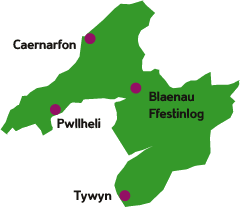
Why become involved?
The Urbanwalks scheme is a feature of the Welsh Assembly Government’s
Climbing Higher Strategy for increasing participation in health enhancing
physical activity, a theme which has also been identified as a priority
within the Gwynedd Health Social care and Well Being Strategy
Walking is acknowledged to be an effective way of improving health and well being among the population of Wales, and Urbanwalks is viewed as another useful vehicle for encouraging people to become more active on a regular basis
The Walking the Way to Health Scheme has been established in Gwynedd since 2002 and Urbanwalks offers a new dimension to work in parallel with this scheme
The Urbanwalks in Gwynedd will target other population groups e.g. those in the workplace who may use these routes for walking to and from work or for brisk walking during the lunch break
Why were the specific areas
chosen ?
Caernarfon and Blaenau Ffestiniog were initially chosen as towns which are
situated in areas of deprivation.
Blaenau Ffestiniog’s electoral division of Bowydd and Rhiw is a Communities
First area and Welsh Assembly Government funding has been granted to the
Corun I Sawdl group which is an inequalities in health group addressing
the needs of women and families.
Blaenau Ffestiniog and Caernarfon along with Pwllheli are more densley populated than the surrounding rural villages, and all feature large residential areas. The development of a new walking network will create an interest for both the local population, employees commuting from the catchment villages and tourists alike.
Caernarfon is the administrative centre for Gwynedd Council
with satellite Council offices in Pwllheli. As a major employer in the area,
this means a significant number of workers can be targeted by this initiative.
Tywyn which is situated in South Gwynedd has a large resident elderly population
and is an area of low income. The area easily lends itself to the development
of a network of walking routes which would again encourage local residents
to improve their health by walking regularly in their own neighbourhood.
Target population group?
All ages but with specific emphasis on those who are sedentary and would
benefit from regular walking
Contact Information
For more information on the Urbanwalks programme in Gwynedd please contact:
Richard Glynne Jones
Green Transport and Cycling Development Officer
Gwynedd Council
01286 679455
Richard.GlynneJones@gwynedd.gov.uk
Health benefits of walking
Significant health benefits can be obtained by taking the right amount of
physical activity.
The current adult recommendation is at least 30 minutes of moderate intensity activity on five or more days of the week. Alarmingly, only about 37% of men and 25% of women currently achieve the recommended levels. Brisk walking is the perfect activity to help you meet the current recommendations.
Benefits of regular physical
activity
Reduce high blood pressure – Moderate intensity activity, such as
brisk walking, appears to be at least as effective in reducing blood pressure
as more vigorous activity.
Prevention of Diabetes – Exercise greatly reduces the risk of developing Type 2 Diabetes.
Helps reduce weight – Physical activity in combination with a healthy diet can help to reduce weight and maintain weight loss.
Mental health benefits – Activity can help to reduce anxiety and depression. It also helps to improve self confidence.
Reduces risk of falls – Especially in the elderly. Physical activity can improve balance, co-ordination and joint flexibility.
Prevents development of Osteoarthritis and Osteoporosis in certain groups.
Increases strength in your heart, lungs and bones.
Improves your mobility and general well-being.
Provides you with more energy and promotes a better night’s sleep.
How much walking should I do?
Walking will only contribute to the maintenance and improve-ment of health
if it is of sufficient intensity and regularity, and is performed for a
sufficient length of time. However, any walking is better than none. People
may need to build up their level of activity gradually and for most inactive
people gentle strolling is a good start point.
Frequency – Most days of the week (at least 5).
Intensity – At a pace faster than a stroll (see How will I feel? section).
Time – Ideally this should be one continuous session of activity of 30 minutes, but 3 periods of 10 minutes or 2 periods of 15 minutes will work just as well.
How will I feel?
Whilst being physically active you may feel some changes happening to the
body, these are normal for everyone, and here is a list to help you understand.
You may: Feel a little out of breath, this is fine as long as you are able to hold a conversation without gasping for air.
You may: Feel a little clammy and warm, which is due to increased blood flow around the body.
You may: Feel a little aching in your muscles (calf, thighs etc). This is due to the body undertaking increased activity. Ensure you work at a moderate level and do not over do it.
What will I need?
Good footwear with laces so that the foot has support. Your footwear does
not have to be expensive just sensible. Do not wear shoes of the slip-on
variety or those with elevated heels.
Take some water with you. Make sure you don’t allow yourself to become thirsty as this indicates that you are dehydrated. Drink little sips often, especially if you are sweating.
In Britain today 70% of the population are inactive, with
1 in 5 adults now classed as obese. Inactivity is now recognised as a major
health and social burden costing the economy £8.2 billion per annum
in England alone.
Remember; every step counts – make the ‘active’ choice
every time!
Use these routes to help you on your way to 10,000 steps a day. Be healthy, stay safe and have fun.